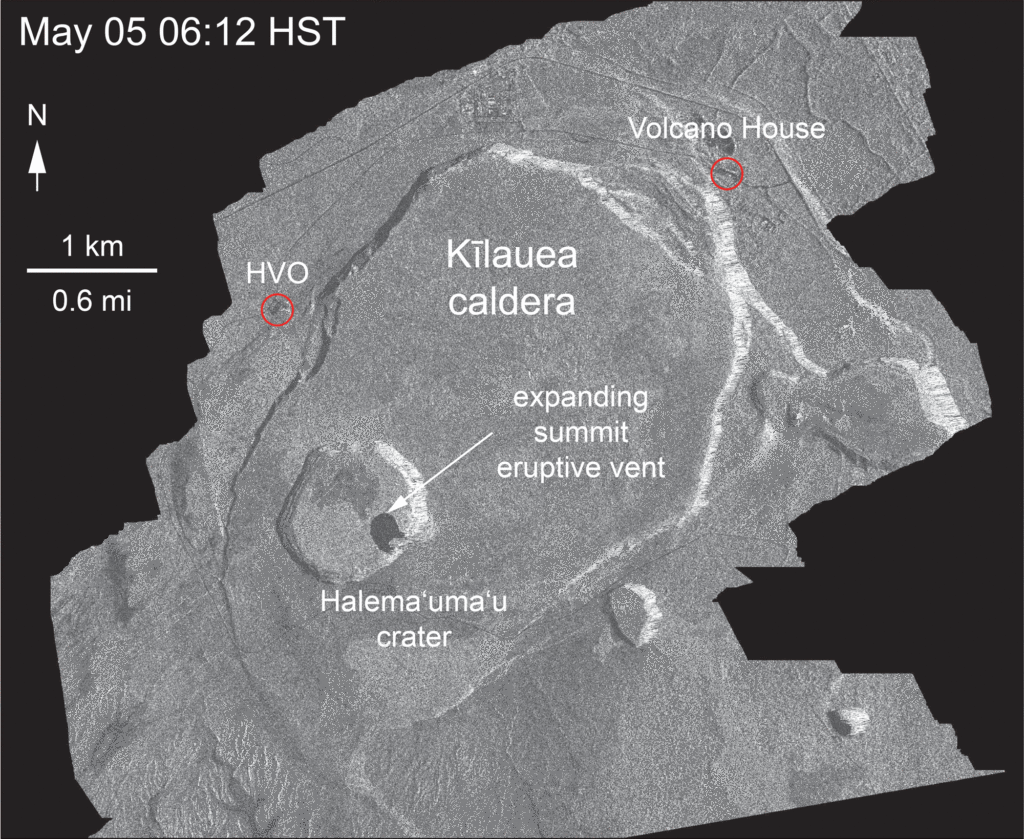11 PM: Strong Thermal Upwelling
This news story will be updated throughout the day as new information becomes available and new articles will be added to the website’s “News” section. Previous information about ongoing events can be found in Big Island Now’s “Volcano Blog” section.
KĪLAUEA SUMMIT LIVESTREAM
CLICK HERE TO VIEW INTERACTIVE MAP
Friday, June 8, 2018, 11 p.m.: Strong thermal upwelling
Lava continues to erupt from Fissure 8, with vigorous fountains reaching heights of about 200-220 feet. Observers on the late afternoon overflight reported no significant changes in the Fissure 8 flow field, which continues to supply lava to the ocean entry at Kapoho. Two vigorous steam plumes are rising from the ocean flow front and being blown inland. Strong thermal upwelling was noted in the ocean extending up to 1000 yards out to sea from the visible lava front. Heavy gas and steam emissions were noted at fissures 9 & 10, but lava emission is occurring only at Fissure 8.
Summit
Low level ash emissions continue at the summit with slowly increasing seismicity, indicating that another small explosion is likely in the next several hours. Inward slumping of the rim and walls of Halema`uma`u continues in response to ongoing subsidence at the summit.
7 p.m.: Video of overflight
This is a video compilation from a helicopter overflight of Kīlauea Volcano’s lower East Rift Zone on June 6, 2018, around 6:30 a.m.
The video shows the fissure 8 lava fountain feeding a channelized lava flow that travels northeast around the Kapoho cone, and then flows toward the south to enter the ocean at Kapoho Bay and Vacationland. The ocean entry has completely filled Kapoho Bay with lava, building a delta that extends 0.8 miles from shore.
The National Weather Service reports that over the past 24 hours web cams and local reports indicate volcanic emissions continue to erupt from Halema‘uma‘u Crater, an active fissure in Leilani Estates, and from lava flowing into the ocean near Kapoho.
Wind directions in the boundary layer will remain easterly to southeasterly through Saturday morning, pushing any ash and particulates toward the west and northwest of these volcano emission sources. Trace amounts of volcanic ash and Pele’s hair fallout will likely fall over the northern Ka‘ū District, the Puna District, portions of South Hilo area and the Saddle region. This includes the communities of Pāhoa, Kapoho, Hawaiian Beaches, Hawaiian Paradise Park, Glenwood, Mountain View, Nanawale and portions of Hilo.
Pele’s hair and other lightweight volcanic glass particles from a high fountaining fissure in Leilani Estates are being carried downwind. These volcanic particles can cause skin and eye irritation similar to volcanic ash, so avoid exposure. Pele’s hair can scratch glass and car finishes. Use plenty of water to rinse Pele’s hair off vehicles and avoid using windshield wipers.
Avoid excessive exposure to ash which is an eye and respiratory irritant. Those with respiratory sensitivities should take extra precaution to minimize exposure.
6 p.m.: 12 rockfalls recorded in Puʻu ʻŌʻō
Vigorous eruption of lava continues from the lower East Rift Zone (LERZ) fissure system in the area of Leilani Estates.
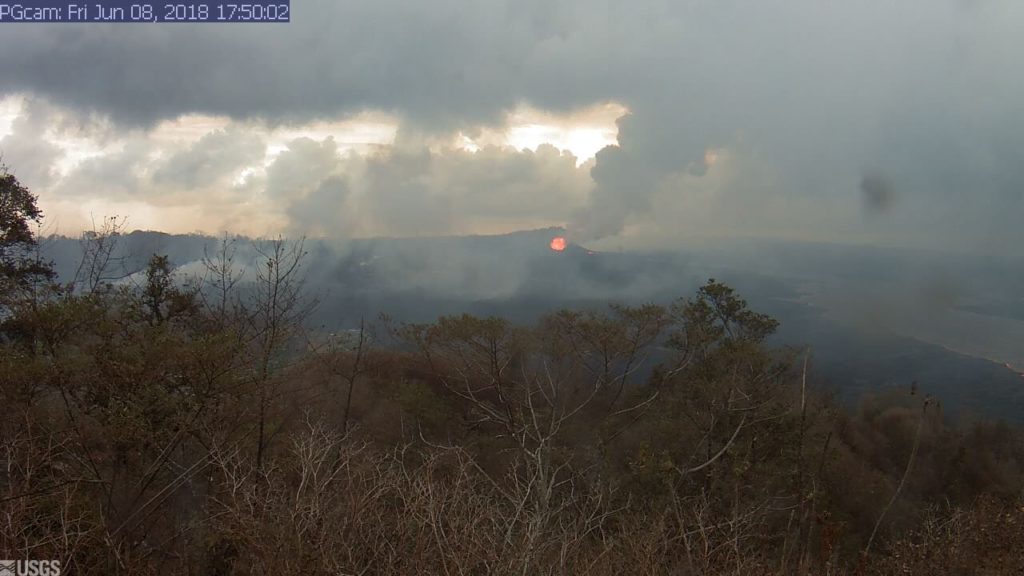
Live Panorama of Lower East Rift Zone Camera from Lower East Rift Zone [PGcam]
Last Updated June 8, 2018, at 5:50 p.m.
Following a magnitude-3.2 earthquake at the summit, 12 rockfalls were recorded in Puʻu ʻŌʻō between 10:31 and 10:56 a.m. with a prominent, but brief, red dust plume ejected into the air around 10:50 a.m..
Pele’s hair and other lightweight volcanic glass from high fountaining of Fissure 8 are falling downwind of the fissure and accumulating on the ground within Leilani Estates. High winds may waft lighter particles to greater distances. Residents are urged to minimize exposure to these volcanic particles, which can cause skin and eye irritation similar to volcanic ash.
The National Weather Service reports high levels of vog and sulfur dioxide from the fissure system are moving north and settling in the Saddle area. Vog will limit visibility on some roads to a quarter of a mile. Drive with caution.
Due to volcanic emissions and changing wind conditions, the following guidance is given:
- Residents in Leilani Estates, and other areas affected by SO2, should take measures to reduce exposure by sheltering in place or leaving the area.
- Stay alert and be ready to leave the area should conditions change.
- You can monitor sulfur dioxide and hydrogen sulfide on Hawaii Island by visiting the Civil Defense website or going directly to www.epa.gov/kilaueaairdata.
Due to volcanic activity, the following policies are in effect:
- The mandatory evacuation order continues for all areas of Leilani Estates, at Pomaikai Street and to the east.
- The curfew has been lifted west of Pomaikai and is open only to residents with official credentials.
- Government Beach Road, between Kahakai Boulevard and Cinder Road, is open to Waa Waa and Papaya Farms Road only to residents with official credentials; there is no curfew.
- Residents in these areas should heed warnings from Civil Defense officials and be prepared to evacuate with little notice.
3 p.m.: Civil Defense Video Update
https://www.facebook.com/BigIslandNow/videos/1680041768740032/
1:20 p.m.: Vog wedging in Saddle Road area
The National Weather Service reports high levels of vog and sulfur dioxide from the fissure system are moving north and wedging in the Saddle area. Vog will limit visibility on some roads to a quarter of a mile. Drive with caution. The Big Island interior and south are expected to have increased levels of vog until tonight.
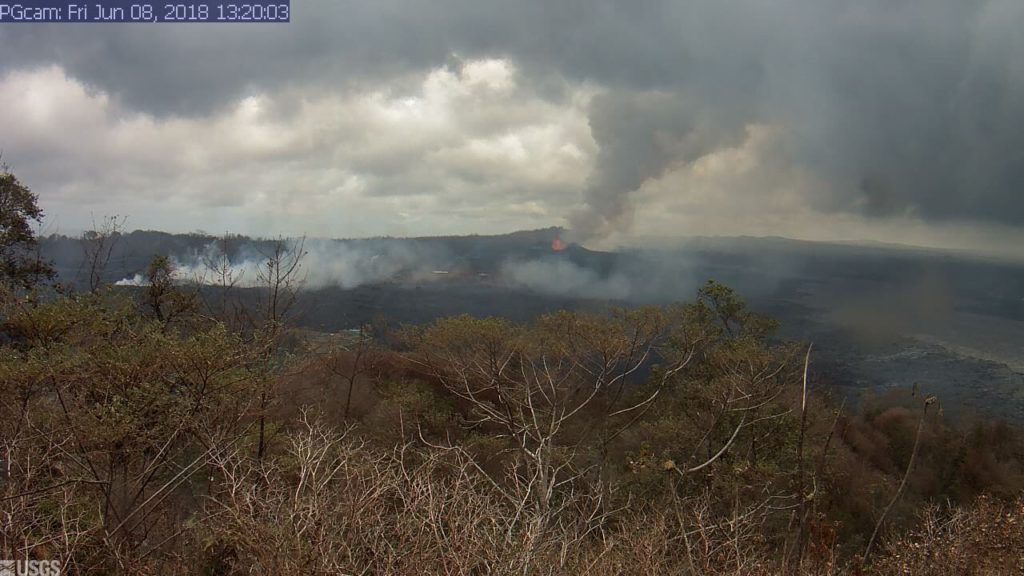
Live Panorama of Lower East Rift Zone Camera from Lower East Rift Zone [PGcam]
Last Updated June 8, 2018 at 1:20 p.m.
- The Department of Health recommends limiting outside activities and stay indoors if you have breathing issues.
- Stay alert and be ready to leave the area should conditions change.
- N-95 masks that were distributed are for ash or vog particulate and will NOT protect from gasses or vapors, including SO2.
- You can monitor sulfur dioxide and hydrogen sulfide on Hawaii Island by visiting the Civil Defense website or go directly to www.epa.gov/kilaueaairdata.
Due to volcanic activity, the following policies are in effect:
- The mandatory evacuation order continues for all areas of Leilani Estates, at Pomaikai Street and to the east.
- The curfew has been lifted west of Pomaikai and is open only to residents with official credentials.
- Government Beach Road, between Kahakai Boulevard and Cinder Road, is open to Waa Waa and Papaya Farms Road only to residents with official credentials; there is no curfew.
- Residents in these areas should heed warnings from Civil Defense officials and be prepared to evacuate with little notice.
9 a.m.: Vog expected to increase for interior and south Big Island
The National Weather Service reports high levels of vog and sulfur dioxide from the fissure system are moving north and wedging in the Saddle area, creating poor visibility on the roads. Drive with caution. The Big Island interior and south are expected to have increased levels of vog until tonight.
Due to volcanic emissions and changing wind conditions, the following guidance is given:
The Department of Health recommends limiting outside activities and stay indoors if you have breathing issues.
Stay alert and be ready to leave the area should conditions change.
N-95 masks that were distributed are for ash or vog particulate and will NOT protect from gasses or vapors, including SO2.
You can monitor sulfur dioxide and hydrogen sulfide on Hawaii Island by visiting the Civil Defense website or go directly to www.epa.gov/kilaueaairdata.
Due to volcanic activity, the following policies are in effect:
- The mandatory evacuation order continues for all areas of Leilani Estates, at Pomaikai Street and to the east.
- The curfew has been lifted west of Pomaikai and is open only to residents with official credentials.
- Government Beach Road, between Kahakai Boulevard and Cinder Road, is open to Wa‘a Wa‘a and Papaya Farms Road only to residents with official credentials; there is no curfew.
- Residents in these areas should heed warnings from Civil Defense officials and be prepared to evacuate with little notice.
6 a.m.: Overnight explosion at Kīlauea Summit spreads ash fallout through Ka’ū
Hawaiian Volcano Observatory reports that vigorous lava eruptions continue in the lower East Rift Zone.
Fissure 8 is producing a large channelized flow that is entering the ocean at Kapoho Bay and producing a large laze plume.
Due to the lava entering the ocean, the following policies are in effect:
- Laze is formed when hot lava hits the ocean sending hydrochloric acid and steam with tiny glass particles into the air.
- Health hazards of laze include lung damage, and eye and skin irritation.
- Be aware that the laze plume travels with the wind and can change direction without warning.
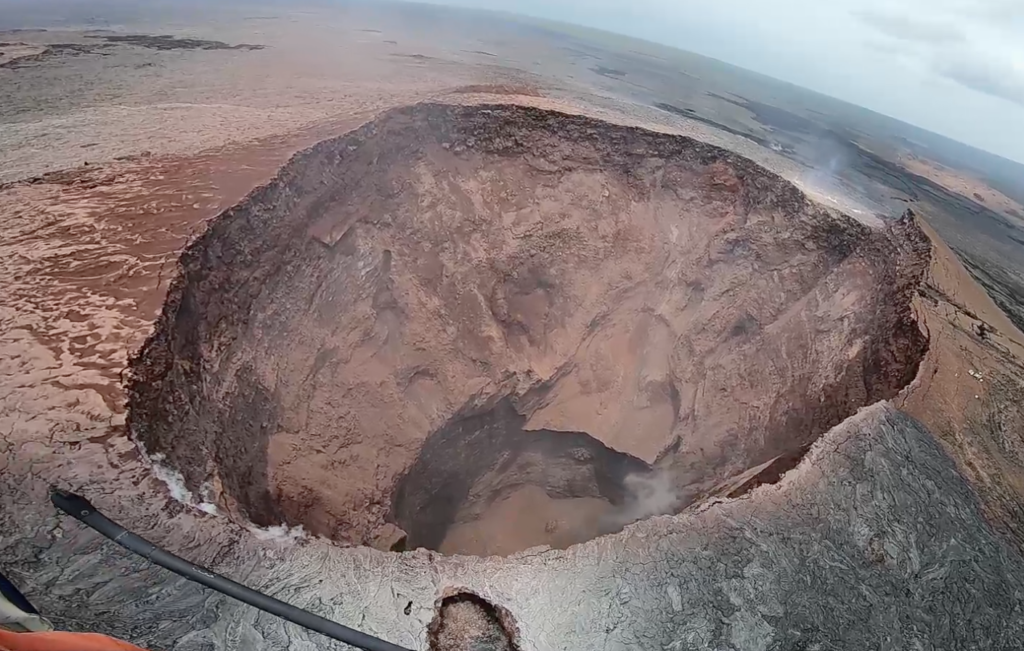
Clear conditions at Pu‘u ‘Ō‘ō provided good views into the crater. The crater floor collapsed, and the lava lake drained, a little more than a month ago. The crater now has a funnel-shape geometry with a deeper cylindrical shaft. Rubble fills the base of the shaft. PC: USGS
Due to the current volcanic activity, the following policies are in effect:
Leilani Estates West of Moku Street is open only to residents with official credentials; there is no curfew.
- Government Beach Road, between Kahakai Boulevard and Cinder Road, is open to Waa Waa and Papaya Farms Road only to residents with official credentials; there is no curfew.
- Residents in these areas should heed warnings from Civil Defense officials and be prepared to evacuate with little notice.
- The shelter at Pāhoa Community Center is open and pet-friendly. The Kea‘au Armory shelter has reached capacity.

Another explosion at the summit of Kīlauea: On June 6, at 4:07 p.m. an explosion within Halema‘uma‘u sent an ash and gas plume to a height of about 10,000 feet above sea level. The explosion released energy equivalent to that of a magnitude-5.6 earthquake; a result of the explosion-related energy release was ground shaking felt throughout the summit area. This plume is typical of those produced by the larger explosions that have occurred at Kīlauea’s summit.
Hawaiian Volcano Observatory reports volcanic gas emissions remain very high from fissure eruptions. Monitor sulfur dioxide and hydrogen sulfide on Hawai‘i Island by visiting the Civil Defense website or go directly to www.epa.gov/kilaueaairdata
Hawaiian Volcano Observatory also reports that a steam explosion occurred at the Kīlauea Summit early this morning, so be aware of ash fallout if your commute takes you through Ka’ū.
4:28 a.m.: Volcanic emissions likely
A 5.5 magnitude earthquake occurred at 2:45 a.m. this morning at the Kīlauea Halemaumau Crater, likely producing another ash cloud. Additionally, over the past 24 hours, webcams and local
reports indicate volcanic emissions continue to erupt from Halemaumau Crater, an active fissure in Leilani Estates, and from lava flowing into the ocean near Kapoho.
Wind directions will become more easterly to southeasterly this morning through Saturday morning, pushing any ash and particulates toward the west and northwest of these volcano emission sources.
Trace amounts of volcanic ash and Pele’s Hair fallout will likely occur over the northern Ka‘ū District, the Puna District, portions of South Hilo area and the Saddle region. This includes the communities of Pāhoa, Kapoho, Hawaiian Beaches, Hawaiian Paradise Park, Glenwood, Mountain View, Nanawale, and portions of Hilo.
Pele’s Hair and other lightweight volcanic glass particles from a high fountaining fissure in Leilani Estates are being carried downwind. These volcanic particles can cause skin and eye irritation similar to volcanic ash, so avoid exposure. Pele’s Hair can scratch glass and car finishes. Use plenty of water to rinse Pele’s Hair off vehicles and avoid using windshield wipers.
Avoid excessive exposure to ash, which is an eye and respiratory irritant. Those with respiratory sensitivities should take extra precaution to minimize exposure.
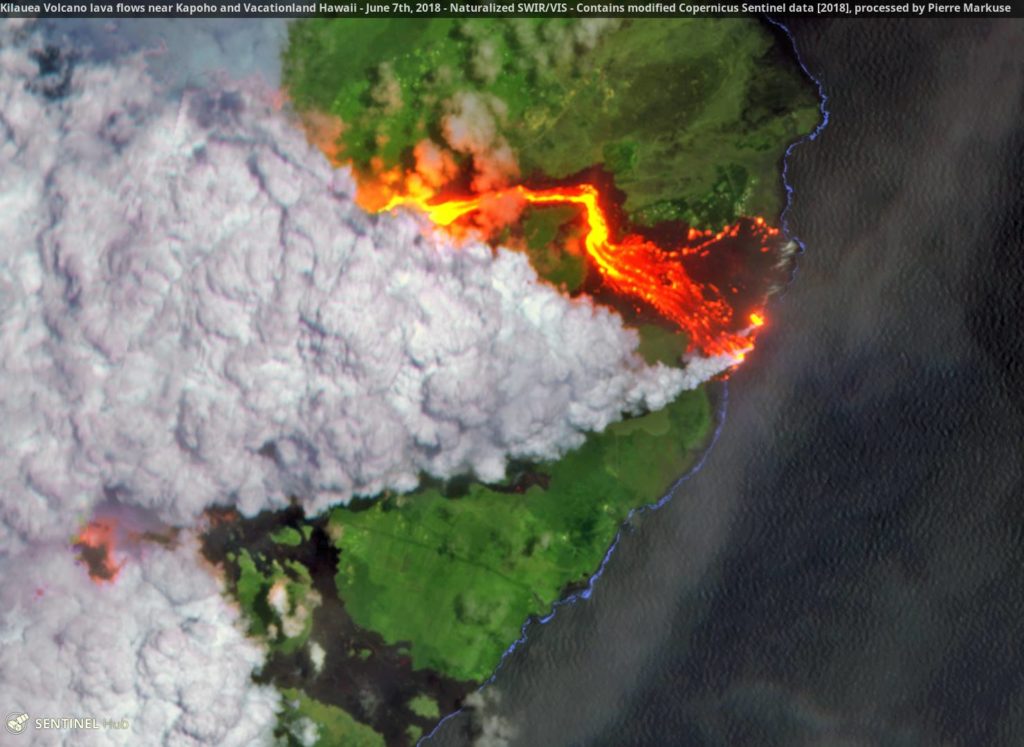
June 7, 2018: ESA – European Space Agency Sentinnel2 satellite image of the Fissure 8 channelized lava flow. The channel bends toward the south at Kapoho Crater then broadly spreads over the Kapoho area before entering the ocean. Note the red colors along the northern margin of the broad area—this is where the flow began expanding into Beach Lots yesterday. The laze plume rises from the ocean entry and combines with rain clouds.
3 a.m. Civil Defense message for Ka’ū
Hawaiian Volcano Observatory reports that an explosive eruption at Kīlauea summit has occurred.
The resulting ash plume may affect the surrounding areas. The wind may carry the ash plume to the southwest toward Wood Valley, Pahala and Ocean View.
The danger from this eruption is ash fallout. The major response is to protect yourself from fallout.
If you are at home, stay indoors with the windows closed. Turn on your radio and listen for updates from authorities.
If you are in your car, keep the windows closed. Ash fallout may cause poor driving conditions, due to limited visibility and slippery driving conditions. Drive with extreme caution, or pull over and park.
After the hazard has passed, check your home, and especially your catchment system for any impact that may affect your water quality.
Thursday, June 7, 2018, 10:22 p.m.: HAWAIIAN VOLCANO OBSERVATORY STATUS REPORT
Kīlauea Volcano Lower East Rift Zone
Vigorous eruption of lava continues from the lower East Rift Zone (LERZ) fissure system in the area of Leilani Estates.
Lava fountaining at Fissure 8 continues unabated with fountain tops reported between 170-200 feet. This activity continues to feed a lava channel flowing east towards the ocean entry in the Kapoho Bay area. Bad weather and poor visibility grounded the late afternoon overflight but ground observers confirm lava continues to enter the sea as of early evening.
No other fissures are active.
Pele’s Hair and other lightweight volcanic glass from high fountaining of Fissure 8 are falling downwind of the fissure and accumulating on the ground within Leilani Estates. High winds may waft lighter particles to greater distances. Residents are urged to minimize exposure to these volcanic particles, which can cause skin and eye irritation similar to volcanic ash.
HVO field crews are on site tracking the fountains, lava flows, and spattering from Fissure 8 as conditions allow and are reporting information to Hawai‘i County Civil Defense. Observations are also collected on a daily basis from cracks in the area of Highway 130; no changes in temperature, crack width, or gas emissions have been noted.
Volcanic gas emissions remain very high from Fissure 8 eruptions. For the next few days, easterly wind conditions may bring vog not only to the south and west sides of the Island of Hawai‘i, but also upslope to the island’s interior.
The ocean entry is a hazardous area. Hazards include walking on uneven, glassy lava flow surfaces and around unstable, vertical sea cliffs. Venturing too close to an ocean entry on land or the ocean exposes you to flying debris from sudden explosive interaction between lava and water. Also, the lava delta is unstable because it is built on unconsolidated lava fragments and sand. This loose material can easily be eroded away by surf, causing the new land to become unsupported and slide into the sea. In several instances, such collapses have also incorporated parts of the older sea cliff. Additionally, the interaction of lava with the ocean creates “laze,” a corrosive seawater plume laden with hydrochloric acid and fine volcanic particles that can irritate the skin, eyes, and lungs.
Magma continues to be supplied to the lower East Rift Zone. Earthquake locations have not moved farther downrift in the past few days and the number of located earthquakes remains low. Seismicity remains relatively low in the area with numerous small magnitude earthquakes and low amplitude background tremor. Higher amplitude tremor is being recorded on seismic stations close to the ocean entry.
Additional ground cracking and outbreaks of lava in the area of the active fissures are possible. Residents downslope of the region of fissures should heed all Hawai‘i County Civil Defense messages and warnings.
Kīlauea Volcano Summit
Seismic activity at the summit is increasing, with a few magnitude-3 events in the past several hours. Based on the pattern of previous days, HVO expects a small explosion to occur overnight. Inward slumping of the rim and walls of Halema‘uma‘u continues in response to ongoing subsidence at the summit.
Over the last week, sulfur dioxide emissions from the volcano’s summit have decreased, but emission rates remain high enough to impact air quality in downwind regions. Additional bursts of gas released with intermittent explosive activity are also transported downwind and may temporarily affect air quality as well.
For forecasts of where ash would fall under forecast wind conditions, consult the Ash3D model output here.
Information on volcanic ash hazards and how to prepare for ash fall maybe found at http://www.ivhhn.org/information#ash (health impacts) OR https://volcanoes.usgs.gov/volcanic_ash/ (other impacts).



